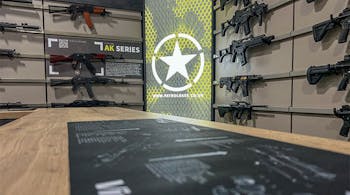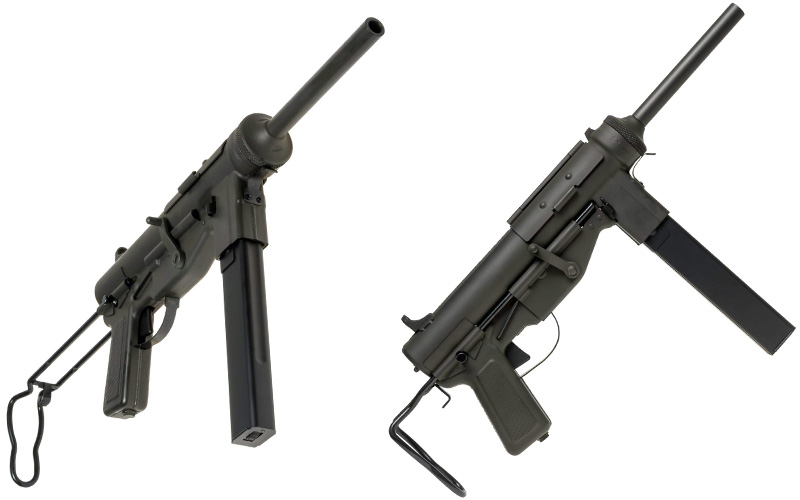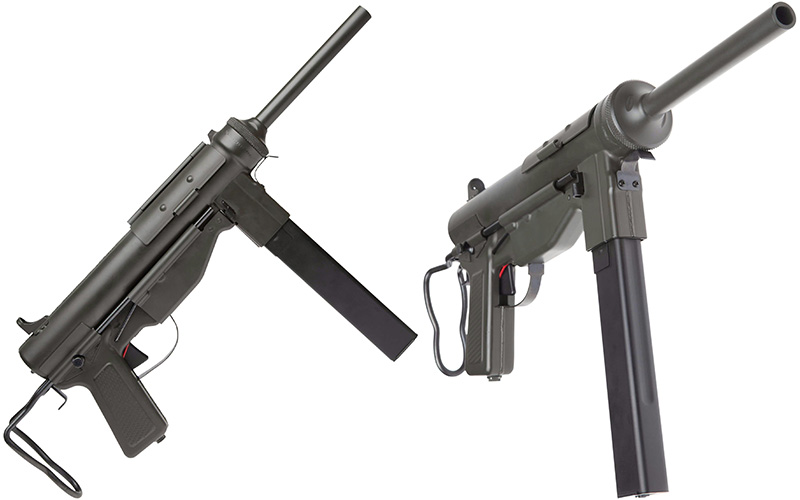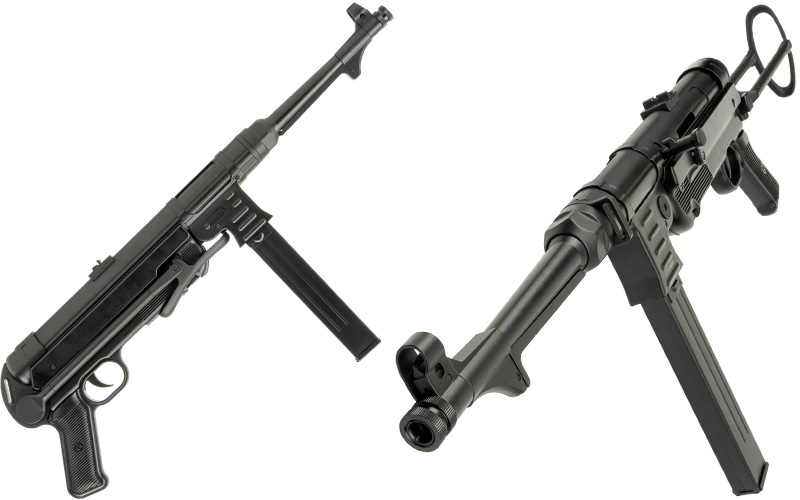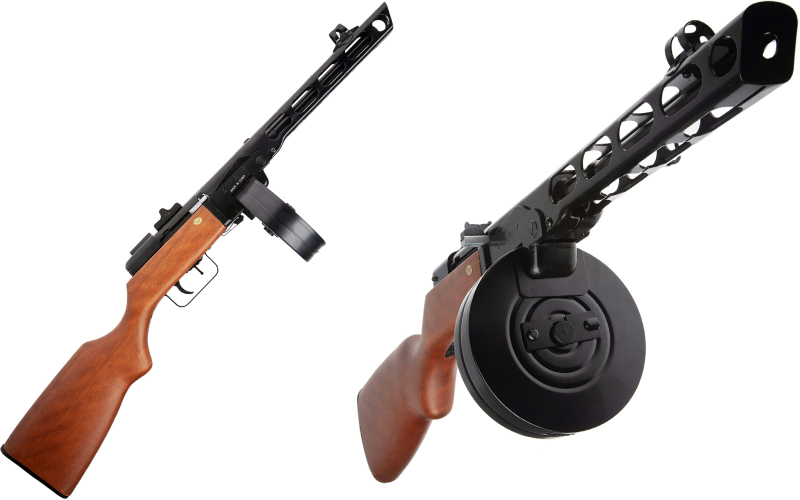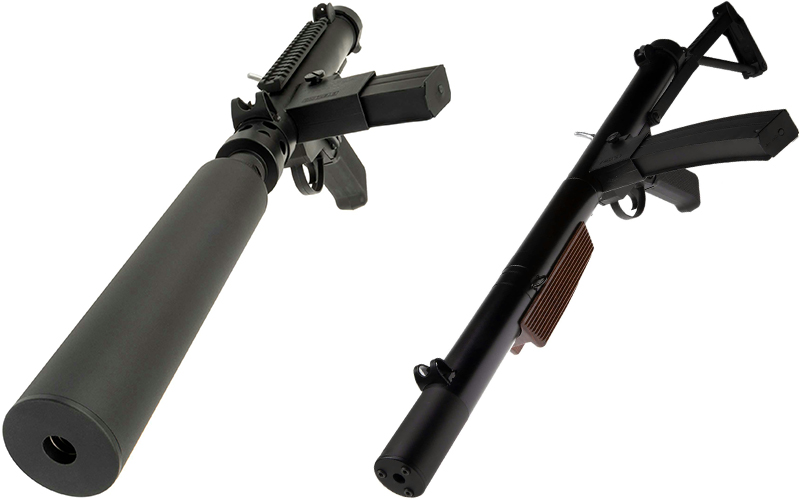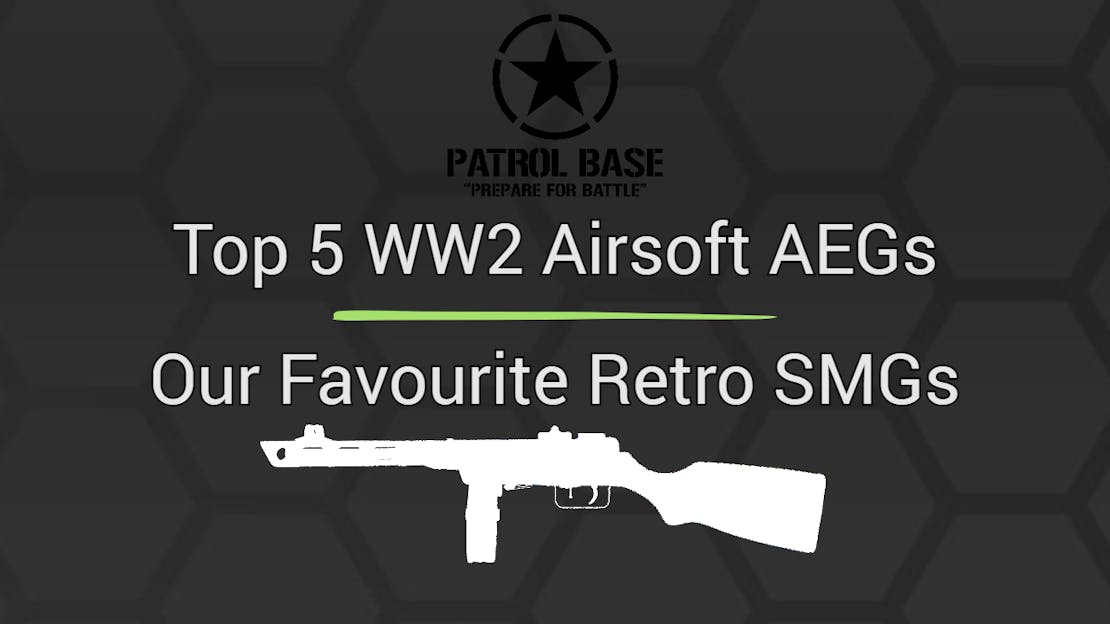
Top 5 WW2 Airsoft AEGs : Our Favourite Retro SMGs
M3/M3A1 Grease Gun - Snow Wolf M3 AEG / Snow Wolf M3A1 AEG
The real Grease Gun
Click for more info
Nicknamed the "Grease Gun" due to its resemblance to the actual grease guns used by mechanics, the M3 was conceived from a similar need to the British at the time; the need for something cheaper to produce than the exceptionally expensive Thompson SMG. Like the Thompson, the Grease Gun was chambered in .45 ACP which was the standard US pistol cartridge of the era.
The Grease Gun was largely based on the original rust bucket SMG, the STEN. However, instead of being the definition of "desperate times call for desperate measures", the Grease Gun actually had quite a good reputation for being reliable. While it was initially disliked due to its primitive appearance, it quickly gained popularity when G.I.'s realised it shoots far better than it looks!
Unconventional, for sure, but effective, surprisingly, the M3A1 went on to serve well beyond WWII being seen in Vietnam, and the final examples were finally retired from service following the Gulf War of 1991.
The Snow Wolf M3/M3A1 Grease Gun AEG
We are very lucky when it comes to Airsoft Grease Guns, as we have both versions available from Snow Wolf. Hopefully, they will release the suppressed version eventually! We can only dream...
Both the Snow Wolf M3 and M3A1 are constructed entirely from metal alloy, giving a realistic weight and feel, even down to the detailed mock welds in all the right spots. The external finish is a very fitting gun metal grey and looks exactly like the finish applied to real Grease Guns.
Make note of the correct M3 ratchet-style charging handle on the right side of the replica, keeping the replica true to form. The Snow Wolf Grease Guns come in full automatic only for maximum authenticity to the real SMG. This does, unfortunately, mean no CQB for the Grease Gun in most cases, though it still makes one heck of an old school run and gun SMG; perfect for an aggressive playstyle outdoors.
One of the nicest inclusions in Snow Wolf's M3 is its electric blowback function. This gives a little bit of recoil from firing, and while it is nothing close to the recoil from a real .45 simple blowback SMG it makes the firing experience a bit different, and great fun compared to normal AEGs.
This M3A1 variant deletes the ratchet-style charging handle in favour of a deep thumb hole in the mock bolt, which can be used to retract it for HOP-up adjustment. Other than that, these replicas are nearly identical, except the M3A1 also omits the mechanical blowback system, so if that's not to your taste this would be the choice for you!
Snow Wolf's Grease Guns use a proprietary gearbox, but for the upgrade-obsessed this is not a deal breaker as it still uses standard AEG gears and a slider adjustable HOP-up, meaning you can still upgrade this to your liking.
The Grease Gun is a bit more conventionally laid out compared to other war-time platforms, so if it's something more familiar you are looking for the Grease Gun would be a fine choice. Even if it does look a bit odd at first...
MP40 - AGM MP40 AEG
The real MP40
Click for more info
Like many SMGs of the era, the MP40 finds its routes with the Schmeisser MP18 of WW1 and was derived from the earlier MP38 SMG, which was itself based on the Erma MP36 design.
The MP40 was incorrectly known as the "Schmeisser" by the Allies, even though it was actually designed by Heinrich Vollmer, not Hugo Schmeisser. Poor Vollmer! It must be a terrible feeling designing one of the best SMGs of WWII and not getting the deserved recognition!
The MP40 was one of the first of the so-called "second generation" of submachine guns which are generally defined as prioritising ease of manufacture and tend to use a stamped steel receiver like the IMI Uzi and H&K MP5 which would follow far later.
The MP40 was well-liked and served well over its lifespan, only being let down by its double stack single feed magazine, just like the STEN and Grease Gun. This is no coincidence, as all of these SMGs made use of the MP18/28 magazine design which was functional, but not the best design out there. That will teach those Brits and Yanks for copying the Germans' homework!
The AGM MP40 AEG
AGM's MP40 boasts an alloy upper receiver, grip frame and stock, and a polymer lower receiver, just like the real thing. One of the neat things about the AGM MP40 is the ability to quickly field strip it in a very similar manner to the real SMG. Obviously being an AEG, this cannot be perfect but is close enough that accessing the internals and battery compartment is Kinderleicht (easy as pie).
The MP40's unique gearbox is compatible with both AEG gears and motors; good news for those who simply cannot leave an AEG as it came from the factory, and simply must upgrade everything. AGM's MP40 also shares magazines with their STEN, meaning if you have both of these WWII SMGs you only have to buy one loadout of mags!
On the outside, there is only one thing which is "wrong" with the AGM MP40, and it is actually a useful feature if you attend CQB skirmishes. The fire selector found on the left side of the receiver is not an authentic feature, as the real MP40 only fires in fully automatic, but allows you to tear up the CQB site with an old-school aesthetic if you so choose!
This fire selector can be removed with modifications if you are more of a stickler for the details, and with that modification done the AGM MP40 could pass as the real thing, even under the scrutiny of a historical firearms buff!
PPSh-41 - S&T PPSh-41 EBB AEG
The real PPSh-41
Click for more info
The PPSh-41 was used in immense numbers by the Soviet Red Army during WWII and was well known for its extremely high rate of fire, and the 71-round drum magazine it was issued with. The PPSh-41 was named for a combination of the weapon type and the designer's surname, as was the Soviet convention at the time. "PP" denotes Pistolét Pulemyót, and "Sh" stands for Shpagin, after the designer Georgy Shpagin.
The drum magazine, despite being one of its most recognisable features was not the most reliable design, and often drum magazines were not interchangeable and had to be kept with the gun they were built for. Later in the war, the PPSh-41 was equipped with a more conventional box-style 30-round magazine that was easier to carry and far more reliable than the slick-looking drum mag we often see this SMG toting.
Although it was intended to be a simplified derivative of the earlier PPD40 SMG, the PPSh-41 was remarkably complex and didn't go to anywhere near the lengths the Brits and Americans did with the STEN and Grease Gun respectively.
The PPSh-41 had a drop safety built into its charging handle, which the STEN really needed but never got. It also had a fire selector switch within the trigger guard and most surprisingly, semi-auto firing mode, which was absent on the MP40 and STEN for simplicity reasons. The magazine release even folds flat against the receiver when not in use to prevent snags and accidental magazine drops.
A great design hampered by production quality control issues and a lack of available materials, the PPSh-41 was later replaced by the PPSh-43, which was the SMG the Soviets really needed, and was far simpler to manufacture, used fewer scarce materials and removed a lot of the advanced functions of the PPSh-41 which simply weren't necessary during wartime, wherein quantity is more important than quality by an order of magnitude.
The S&T PPSh-41 EBB SMG
The S&T PPSh-41 is probably the best-built SMG on our list, being constructed entirely from stamped steel and real wood components, just like the real thing. This SMG has significant weight and heft, tipping the scales at an immense 3.8kg which is nearly bang on the weight of the real PPSh.
The finish on the steel parts is an authentic gloss black paint, matching the real deal when it came out of the factory over 80 years ago. The wood looks a bit too fresh to be a real PPSh which wasn't made with the utmost care, unlike the S&T example which was clearly made to impress with its light woodgrain and flawless form.
Roughing the wood up a bit would make this PPSh-41 look a bit more authentic, but it would be a real shame to ruin such well-finished and attractive-looking wood. It's up to you, maybe the reason your PPSh-41 is so immaculate is that it was made perfectly for display in the Kremlin!
The best feature of the S&T PPSh-41 is its electric blowback system, which reciprocates the mock bolt carrier with each shot, giving off a thunderous sound and drowning out the motor noise with a "chop-chop-chop". Like the Snow Wolf Grease Gun, this blowback isn't anything like the recoil from a real firearm but makes the PPSh a joy to shoot and that bit more immersive.
On the inside the S&T PPSh is every bit as impressive; boasting a quick change spring system, rotary HOP-up unit and the ability to decompress the spring using the charging handle. The latter feature helps preserve the internal spring and reduces wear on the internal components which will help prolong the life of the SMG.
Thompson M1A1 - CYMA CM.051 Thompson "Chicago Typewriter"
The real Thompson SMGs
Click for more info
The M1A1 Thompson was a simplified variant of the M1928 Thomspon which the British military was using at the time at great expense in gold bullion. The M1928 was in all ways a premium firearm, and the M1A1 was conceived after recognising that many of the finishing touches and fine details on the elegant M1928 simply weren't necessary for a mass-produced military firearm.
The M1928 used the contentious "blish-lock" operating system which was intended to provide a slight delay in the opening of the bolt via the use of brass pieces within the bolt, and the theory that the use of different materials would increase friction as the bolt opens and function similarly to a "delayed blowback" firearm.
In reality, this was not very effective, and as such the M1A1 bolt was redesigned to function via "simple blowback", which relies on only the mass of the bolt itself to hold the action closed for long enough that chamber pressure would drop to a safe level before extraction and ejection.
The M1A1 had a repositioned charging handle which was now on the side and as part of the redesign, the ability to use drum magazines was omitted as they were generally regarded as too heavy, unreliable and difficult to carry. The result of the redesign was a heavy but well-liked SMG which was known for being reliable and relatively controllable in full auto.
The M1A1, like the PPSh-41 in Soviet service, was not quite simple enough to equip the US Army with the volume of SMGs it needed and was supplemented in service by the M3 Grease Gun, and other designs in far smaller numbers.
The CYMA CM.051 Thompson Chicago Typewriter AEG
Part WW2 SMG, part L.A. Noire Mafia SMG! CYMA's CM.051 Thompson SMG is a near-perfect replica of the original gun and comes with an alloy receiver and faux wood furniture. Faux though it may be, the furniture on this Thompson is very well done, with a deep and authentic-looking faux wood grain and a shiny lacquer-like finish on the surface.
Thankfully the CYMA Thompson doesn't weigh quite as much as the real thing, but still feels substantial in the hand, weighing in at around 3kg unloaded. The real Thompson weighed around 4.5kg, and if the CYMA replicated this it would detract from the run and gun playstyle Airsoft SMGs lend themselves so well to.
Unlike some of the SMGs on this list, the real Thompson had a semi-auto firing mode, which is correctly replicated on the CYMA Thompson with its dual selector switch setup. The foremost selector switch on the left side controls the firing mode, and the rear selector provides the trigger lock safety function. CQB is a go for this WWII SMG!
On the inside the CYMA Thompson uses a version 6 gearbox, meaning aftermarket gearsets are compatible for those who want more performance, though the pre-installed internals are great as it is. The HOP-up uses a rotary-style adjuster which is accessible through the ejection port when the charging handle is pulled back.
You have the choice of either period-accurate stick magazines or the legendary Thompson drum magazine with this platform. CYMA sacrificed a bit of realism here for a lot of in-game functionality, and if you need to keep heads down in a WWII reenactment skirmish this Thompson can serve as an LMG in disguise!
Sterling Submachine Gun - S&T MK5 (L34A1)/MK7 Para Pistol
The real Sterling SMG
Click for more info
The Sterling submachine gun, developed in the UK during World War II by George William Patchett, was designed to replace the STEN. Originally called the Patchett Machine Carbine, after trialling during WW2, it was officially adopted by the British Army in 1953 as the Sterling L2A1. Manufactured by the Sterling Armaments Company, this 9mm SMG became popular for its reliability, accuracy, and robust design.
In service from the 1950s to the 1990s, the Sterling was used in conflicts like the Malayan Emergency, the Falklands War, and Northern Ireland. Its compact build and 550 rounds-per-minute fire rate made it ideal for close-quarters combat. The SAS and other special forces valued its reliability. Its unique design was also popular in the media, becoming the base platform for many space pistols in popular movies.
Key features included a curved 34-round magazine for smoother feeding, a roller-bearing bolt for reduced friction, and a side-mounted magazine for better prone firing. These design improvements made it far superior to its predecessor, the STEN.
Though retired in the 1990s and replaced by the L85A2 rifle, the Sterling remains a collector's favourite. Its influence endures in modern SMG designs, securing its place in both military history and pop culture.
The S&T Sterling Submachine Guns
So, we know what you're going to say, "This isn't a WW2 SMG". Now, that may be true, but it was initially trialled during WW2, and its iconic look and style were too good to exclude from such a list. So we appreciate that it's technically not a WW2 SMG, it's close enough and awesome enough for us to include it regardless.
There are two choices of Sterling SMG that we have available: the MK5 and the MK7. The MK5 is a very slender platform, basically being one long, continuous piece of metal, this makes it excellent for crawling around or navigating tight spaces as no extra pieces are sticking out other than the magazine.
The MK7 on the other hand, is a very rare variant of the Sterling that was only in production for a few years. The Para-pistol SMG was designed to provide paratroopers and non-infantry personnel with an automatic compact alternative to their pistols. It was sadly, however, rather rapidly replaced by other more compact and lightweight machine pistols.
The rifles come with preinstalled suppressors; the MK5 variant has an integrally suppressed barrel, and the Para Pistol variant has a thread-mounted suppressor that can be removed if you want to futurise this SMG and add a tracer unit!
Both these SMGs boast a large proportion of steel construction, giving them a true-to-life weight and feel. If you want to create a historical loadout but want something a little rarer and less seen, a Sterling SMG is a great choice for you!
So, which one is our favourite? As far as features are concerned, it has to be the S&T PPSh-41. The build is flawless, being constructed predominantly from steel, just like the real thing, and it comes with the iconic drum magazine and an electric blowback system which gives it a lively firing experience.
Looks-wise, it has to go to the AGM MP40, this Airsoft platform looks almost identical to the real German SMG and in terms of recognisability, it's been seen everywhere since WW2, most notably Indiana Jones and the Last Crusade. Plus, its foldable stock is glorious, so minimalistic yet so effective.
If you want to see more Airsoft Historical Replicas, not just the SMGs, make sure to press the button below to view our entire range of iconic platforms from history!

